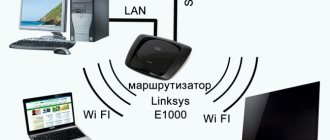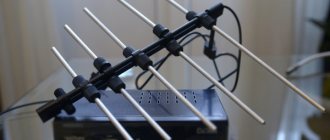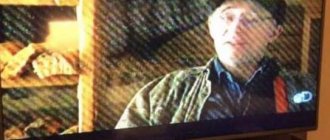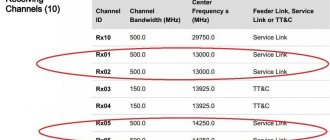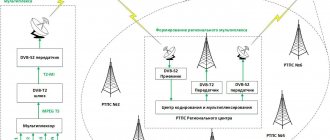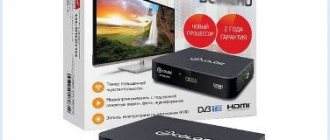Initially, when routers became popular, they had one antenna on board. Do you remember the retractable antenna on the first cell phones? No? And they were! Now you won’t surprise anyone with two or more antennas on a router. In principle, it may not be visible at all. It can be hidden, like on modern smartphones. In this article we will look at why some routers have so many antennas.
Why are antennas needed?
It is clear that any modem is a transceiver device. Initially, we connected to the Internet using cable. And at that time these devices were good. Now an antenna has appeared in the Router ↔ Computer chain. What type it is, hidden or open, doesn’t matter. The main thing is that without it it is impossible to transmit radio waves over distances.
Currently, all devices are equipped with an antenna:
- smartphones;
- Wi-Fi adapters;
- Wi-Fi routers.
Moreover, they may not be visually visible. And we are interested in the location of all antennas of the router.
There used to be phones with antennas sticking out. Now such models are no longer produced. The antenna itself remains, but it is not visible visually. Now they are inside the device.
This phenomenon fully applies to routers. If you have such a device in front of you, but the antenna is not visible, then remember, it is definitely present there. There are no routers, especially those with Wi-Fi functionality, without an antenna. Moreover, there may be several of them:
- one;
- pair;
- three;
- four or more.
As a rule, they are now external. This does not make the signal stronger. It's just that the antenna gain is higher. And the power directly depends on the transmitting device inside the router. This ensures the stability of the radio signal and increases the range. Now we have figured out that the main thing in a transmitting device is the gain. It is due to this that the Wi-Fi coverage area is expanded.
Now, let's move on to the question of why a router needs a lot of antennas.
Cable and antenna adapters
In the 900 MHz range, the issue of cable selection becomes paramount. Domestic television coaxial cables can only be used to a limited extent (the attenuation of more than 30 dB per 100 m is too high). Of the available imported samples, RG6 is a suitable double-braided coaxial cable. You will find it in any store. The attenuation is 20 - 24 dB per 100 m (tested experimentally). Industrial automotive whip antennas typically include RG59 cable with an attenuation of 28 dB at 100 m. A wave channel antenna with a gain of 12 dB and 10 m of RG6U cable give a total gain of 9.6 dB, and at 20 m - 7 dB.
Most phones have a connector for an external antenna. In addition, for each type of phone there is a so-called antenna adapter (about $5), it connects to the specified connector and is a short piece of cable, on one side of which there is a specific telephone high-frequency connector, and on the other - a standard RF connector. Typically, the attenuation in the antenna adapter does not exceed 1 dB. When purchasing an antenna adapter, make sure it is functional. When you plug the adapter into the phone, the antenna built into the phone is turned off and the output stage switches to the adapter. In other words, if you simply connect the adapter to the phone, the signal on the phone's dial should drop slightly. Then you connect an external antenna to the adapter and the signal increases. If everything goes this way, then the adapter is working.
How many antennas are needed?
Old systems were equipped with one antenna, and, at that time, this was enough for slow Internet speeds of one or two megabits per second.
But as time passed, the speeds increased. Old network equipment simply did not meet the new requirements.
For fast Internet, Wi-Fi must be much faster. To improve performance, it was decided to add a second antenna, because one could not cope with the reception and transmission of data (SISO) at the increased speed.
Two or more
Two antennas on the router ensured simultaneous operation of both reception and transmission using MIMO technology. Accordingly, the speeds also increased - up to 144 Mbit/s.
It must be said that modern smartphone models also have two antennas.
Let's add one more
If a 3x3 MIMO or 2x3 MIMO configuration is used for data transmission, then a third antenna may be needed, which also works for reception/transmission. This supports wireless networks at 216 Mbps. If the router can work using the TurboQAM or NitroQAM protocol, then the speed can increase significantly!
What if there are four
For an ordinary apartment with an Ethernet connection via twisted pair, there is no point in additional “antennae”. Theoretically, the speed can be 100 Mbps, but in reality it is lower.
And if you use a simple telephone line using the xDSL protocol, then the real speed is generally 20–30 Mbit/s. In this case, the optimal device would be a router with either two antennas or a built-in one.
It’s another matter if the Internet is distributed via fiber optic networks. They can provide speeds of 1 Gbps and higher. Here's an opportunity:
- live broadcasts of streaming video;
- chatting in Internet;
- Online Games;
- quality TV;
- telephone.
In this case, the use of routers with four “whiskers” will be justified. Especially if there are several Internet users in the house, and everyone has different preferences.
Call us - we will help you with free advice!
In our company you can get answers to questions about which access point is better to purchase or how to install a repeater yourself. If you have already bought something and couldn’t install it on your own, call us, we will suggest the most painless way out of this situation. If you are interested in receiving it, please contact us to submit an application for installation of the system you need.
We will help you choose a mobile amplifier, provide high-quality cellular network coverage, install an antenna for mobile Internet reception, and also implement a WiFi network at your site and the entire surrounding area that supports “seamless” roaming.
If necessary, our company’s specialists will perform diagnostics of already installed systems, and if a breakdown is detected, they will help restore the original functionality of the equipment, or suggest upgrading. Your benefit: individual approach, high-quality installation, professional after-sales service, warranty on work and equipment - all services in one company.
The influence of cellular signals and wi-fi on human health.
Our customers often have questions about the negative impact that cellular repeaters or WiFi access points “possibly” have on human health.
When answering this question, we usually ask a counter question: “Have you ever wondered why the battery in a mobile phone runs out very quickly in an area of poor reception or WiFi network, even if the phone is not used at all?”
This happens because the phone’s transmitter, being in an area of insufficient signal, in order not to lose the connection with the base station, operates at maximum power. And when talking on the phone near the head, such radiation can reach its peak, reaching up to 2 W, which can subsequently have a detrimental effect on health.
The use of a cellular repeater, as well as evenly distributed coverage of the WiFi network at the site, allows us to significantly reduce the harmful effects of a mobile phone on the human body.
What is the difference between an expensive and a cheap communication amplifier?
Today there is a huge amount of equipment on the market, including “gray” ones. Based on our experience, a normal repeater of minimum power, with an annual warranty from the manufacturer, cannot cost less than 9,500 rubles. If you still decide to save money and you don’t care which device to buy - gray or white, just remember that the Chinese are not involved in charity and the cheapness of the equipment is achieved by saving on the cost of the element base.
If you are determined to purchase a reliable repeater or a good wifi access point and use them for many years, then it is better not to skimp on quality. Trust the selection of equipment to competent specialists, or purchase equipment directly from the manufacturer. .
Cost of boosting cellular communications, mobile Internet and Wi-Fi
Today, the service of boosting a mobile signal is quite accessible to the “average” Russian. The cost of installing a repeater is often comparable to buying an average laptop or modern mobile phone.
Do you want to stay connected everywhere? — Contact us and we will offer the best possible options.
We position the router correctly
It may seem strange, but there are some users who consider it a worthy place to place something that is not conspicuous or has an outlet nearby. They don't think about how the router is positioned and how this will affect signal reception/transmission. If the device is installed by a specialist, then he already knows in advance how to properly place and install the equipment.
So where should the router's antennas be located and how should it stand? Obviously, the best position is in the center of the room.
This is partly true. If the apartment is one-room. What if there are two or three rooms?
If there is a dividing wall, then the place for the router is in the largest room on the wall that separates two adjacent rooms. But there are limitations. Household devices such as a refrigerator, microwave oven, stabilizers and other electrical appliances will interfere with the propagation of the radio signal. Therefore, it is better to stay away from all such devices.
It would also be a good idea to take into account where the Internet client is located in neighboring residential premises. The most advantageous installation point is at an equidistant distance from all network consumers. This is the best place to place your device.
What does a cellular signal booster system consist of?
The main elements of such a system are external and internal antennas, which allow amplifying the power of the cellular signal. External antennas are mounted on the roof of the building, they are designed to pick up the signal from the tower, and internal antennas are installed in the house.
The cellular communication amplification system consists of the following elements:
- A two-way amplifier or repeater, these elements are an intermediate link;
- External and internal antennas - the external antenna picks up the signal, and the internal one transmits it;
- Coaxial cable splitters and power divider;
- N-connectors;
- A coaxial wire whose resistance would be 50 ohms.
Internal antennas are installed indoors, through which the amplified signal is transmitted to mobile devices. An external and external antenna connected through a repeater makes it possible to receive a stable signal from a cell tower, where there was none before.
All of the above elements of a cellular communication amplifier can be divided into active, that is, those that require a power source, and passive, which operate without it. The passive elements of the amplification system include antennas, cable and divider.
To strengthen the cellular signal, in some cases, it will help to assemble an outdoor antenna, the circuit diagram of which is presented below.
Router antenna direction
For those who have a router with an internal antenna, this section is not relevant. But if there are two or more “antennae” on the router, then the question of how to correctly position the antennas of the Wi-Fi router will be very acute.
It is possible to adjust the distribution to the parameters of the apartment. But it is necessary to take into account such a parameter as the gain. The greater its value, the more the radius of wave propagation expands.
Now the most important thing is how the radio wave propagates. If this coefficient approaches unity, then the shape of the influence zone is closer to spherical. But modern devices have a coefficient greater than 1.0. Therefore, the shape of the coverage area is disk-shaped. In other words, the signal increases at the edges of the antennas, and decreases at the top or bottom of the “disk”.
What follows from this:
- In the first case, the coverage area of the router can extend to several floors of the building.
- In the second, it is suitable for premises within a one-story house.
Now comes the fun part. Often modern models have several radio channels, for example, by the number of antennas. Therefore, if all the “antennae” are directed in different directions, then we will thereby change the reception/transmission zones along different planes. This will increase the range of the router.
It is also necessary to remember that antennas come in two types:
- Narrowly directed - the signal is collected into a beam and goes in the desired direction.
- Omnidirectional works in all directions.
A router with omnidirectional antennas, and this type is mainly used in modern devices, generally does not need to be aimed specifically somewhere.
Let's return to routers with built-in antennas. They are initially recommended to be mounted vertically on the wall. But since there may be more built-in antennas, for such models the vertical or horizontal position does not matter. Any directional transmission option will ensure stable operation of the device. You can even advise and work with different positions to see when the signal is best.
Device and optimal dimensions
As you know, the 4G modem operates at a frequency of 2100 MHz. It is equivalent to a wavelength of 143 millimeters. Nowadays there are still models that are created at 900 MHz, and those that use a composite order, but they are already losing their relevance.
The key components of the amplifier are:
- vibrator - waves of magnetoelectric oscillations are induced on it, which are sent by the 4G provider’s transmitter;
- antenna wire with a matching element that transmits the induced radio signal from the vibrator;
- block for transmitting a signal from the wire to the modem input;
- a reflector that eliminates signal interruptions and reflective noise - it is needed to increase reception power.
Basic requirements for a vibrator
It is important to pay attention to the type of metal used. As a rule, copper or aluminum is used for the amplifier. In home situations, taking into account the small parameters of the vibrator, it is easier to connect the cable by soldering
For this reason, you should immediately focus on copper, without even evaluating a number of its other positive aspects.
In home situations, taking into account the small parameters of the vibrator, it is easier to connect the cable by soldering. For this reason, you should immediately focus on copper, without even evaluating a number of its other positive aspects.
A special role is played by the configuration and cross-sectional dimensions. It is recommended to construct a Kharchenko antenna from a wire with a cross-section of at least 5 mm² and a diameter of 2.5 mm, since these parameters, according to popular experience, are the most favorable. It’s worth mentioning right away that it is permissible to take a thickness of 2.3 mm with a cross-section of 4 mm², which will not significantly reduce the reception characteristics. If necessary, it is permissible to install with a cross-section of 2.5 mm², but this will already spoil the quality of the signal and increase its attenuation. Although for any specific case or area this may be quite possible, it should be approached individually.
Cable selection
The main difference from standard antennas that a private master may encounter is the size of the wave resistance, and it can be 75 or 50 Ohms. To reduce power losses, it is more reliable to use a wire with lower resistance. It is more suitable in terms of electronic performance, is more consistent, and guarantees the least signal loss. However, when using one of these types of wires, it is better to more accurately select the mechanical dimensions of the vibrator for it. In this case, signal power leaks will be minimal.
Specifics of the reflector design
Any steel plate can serve as a screen. It can be cut out of tin or cut out with a grinder from an unnecessary aluminum pan. If there is no metal, then you can get out of the situation and take plywood or cardboard and cover it with foil. You don’t have to worry about the result—there won’t be a noticeable difference. In any case, the resulting structure will be able to block the moving wave background from different sides.
A used DVD disc performs well. You can increase its effectiveness by covering one side with aluminum foil. This option does an excellent job of reflecting waves. Its additional advantage is its aesthetic appearance and significant ease of work.
To use the disc, you just need to coat it with glue and fix it on the cap of a plastic bottle. You also need to adjust the distance of the vibrator from the reflector. This can be done using additional washers (you can take them from screws) or trimming excess thickness.
https://youtube.com/watch?v=geisHVkqApY
Changing settings
There is another option to improve the quality of the radio pulse - change its settings. Let's consider why to do this.
Your signal may be clogged by transmissions from your neighbors’ router behind the wall, who also distributes Wi-Fi, but to their own apartment and, worst of all, on the same frequency. As a result, you will not receive enough Internet from this.
This problem can be solved by switching to another channel. Most routers do this. They can select the least loaded channel and go to it. To do this, you need to activate the “Auto” item in the list of Wi-Fi channels. Alas, not all devices have this function.
You can try increasing the radio signal power. However, this option is limited to the range from 0 to 100%. But if your router has the ability to increase the power level above the standard values, then this can save the situation.
The increase in power violates State Radio Frequency Commission standards. No one, of course, will control you, but still, keep this in mind.
Process of creation
The assembly steps will depend on what type of device has been selected.
Simple external device
A conventional external antenna is a device for enhancing the quality of a cellular network signal, which is installed outdoors. It can have a different appearance, for example, in the form of a large plate catcher or a simple television antenna adapted for a 3G signal.
Note! In the case of external antennas, the quality of insulation plays a big role, since the amplifier will have to work in different weather conditions
It is important in such devices to choose the best location for installation and direction towards the base station. In addition, they should be properly insulated to prevent water from getting into areas with microcircuits and wire connections.
In addition, they should be properly insulated to prevent water from getting into areas with microcircuits and wire connections.
It is important in such devices to choose the best location for installation and direction towards the base station. In addition, they should be properly insulated to prevent water from getting into areas with microcircuits and wire connections.
The reflector is created from a metal sheet, which is recommended to be rounded. If there is no steel, then you can use plywood or cardboard, which should be wrapped in foil.
Panel antenna
It is a large metal plate with patches or small panels attached to it for better capture. To create a 4G antenna - a “gun” - with your own hands you need to buy:
- ribbed galvanized iron to create a panel (one sheet with dimensions 334x290 mm);
- to create patches, four sheets of galvanized iron (dimensions 118x70.5 mm);
- copper wire (diameter 2 mm);
- copper foil, preferably several large pieces (cut a circle with a diameter of 21 mm);
- foam for patches;
- Super glue.
DIY Kharchenko antenna for 4G modem
It was named after the scientist who first invented such a device. It is one of the simplest antennas in design for a mobile signal. For assembly you need:
- spiral wire;
- coaxial cable;
- rod wooden slats;
- pliers, hammer, knife.
Note! Before assembly, it is very important to carry out a quality calculation. To do this, it is recommended to visit specialized sites that have online calculators
To do this, it is recommended to visit specialized sites that have online calculators.
Assembly steps:
- determine the polarization and frequency of the wave. The device must be linear;
- make a biquad type antenna device in the form of a zigzag from copper. All elements must be located at the corners, one of which touches. For horizontal type polarization, the figure eight must stand upright. If you do vertical polarization, then the structure is installed on its side;
- the side of the square is calculated using a special formula: wavelength divided by four;
- assembly of the structure, it should be oval in shape.
Thus, there is nothing difficult in creating an amplifying device. The main thing is to choose the appropriate type, follow the instructions above and make accurate calculations.
How to determine whether a dacha falls into the CETV zone
Determining whether it is possible to organize digital television in a dacha is quite simple. To do this you need to go to the website rtrs.ru. There is a link to an interactive map right on the main page of the resource. By selecting your locality on it, you can find out which multiplexes broadcast in a given point of the country.
The website indicates the frequencies of stations that broadcast digital TV. It is recommended to write them down; they will be needed to manually configure the receiver or modern TV with a DVB T2 tuner. There is also a scale bar on the map. Using it, you can determine the distance to the translator in order to select the optimal antenna model that will need to be installed to receive digital television in the country.
How to make a repeater and signal amplification system with your own hands
You can easily assemble such an amplifier yourself. You need to start with the antenna. After assembly, it is recommended to install it and check the quality of the signal enhancement. Perhaps one antenna will be enough. If not, then a repeater is required. It is difficult to create a homemade product at home, so it is recommended to purchase a ready-made one. When everything is ready, you can assemble the amplification system. To do this, you need to connect all the listed elements and configure them to work correctly.
Important! Such a control system is a combination of a repeater (amplifier) and an antenna. You can improve the 4G network signal using an antenna
If it is not enough, then you need to assemble an amplification system that will make the reception signal as powerful as possible
You can improve the 4G network signal using an antenna. If it is not enough, then you need to assemble an amplification system that will make the reception signal as powerful as possible.
Reasons for deteriorating broadcast quality
Poor signal quality can have several reasons:
- greater distance from the TV tower;
- densely built area and the presence of nearby industrial enterprises that create interference on the air;
- terrain features (poor signal is typical for lowlands);
- weather conditions: strong wind, snowfall, thunderstorm, etc.;
- equipment malfunction (TV, digital set-top box or antenna), problems with cables and connectors.
Some of these factors can lead to short-term signal deterioration, while others lead to permanent problems with the image and sound of digital channels.
Unlike analog TV, where the quality deteriorates gradually, digital television is characterized by sudden changes: freezing of the picture, disintegration into “cubes”, complete disappearance, “out of sync” of sound and image. This happens when the input signal parameters deteriorate.
